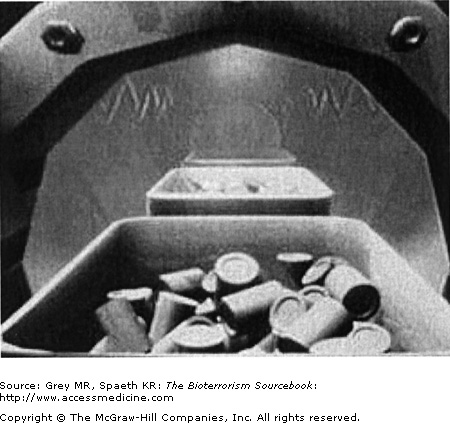Introduction to Nuclear and Radiation Weapons: Introduction
“It’s not a matter of if; it’s a matter of when.”
General Eugene Habiger, head of American strategic weapons until 1998, referring to the likelihood of a terrorist act in the United States involving a radiologic device.
Humans evolved in a universe where ionizing radiation is a fact of life. Yet for many it remains a mysterious force, deadly, unseen, and impossible to detect with our senses. Atomic energy and the atomic bomb loom large in a public psyche shaped by post-WWII geopolitics. For these reasons, public concern with atomic energy, nuclear waste, and the risk of nuclear terrorism probably exceeds that of any other agents. The world is filled with a variety of sources of ionizing radiation, and consequently, many experts consider the likelihood of a terrorist act involving nuclear material to be simply a matter of time. For decades, life on earth was threatened by the Cold War. In the post-September 11 world, the nuclear threat is more limited and ironically more unpredictable. This chapter provides a brief synopsis of the possible scenarios in which terrorists could use nuclear weapons or nuclear material (Table 29–1).
| Radiation Source | Example |
|---|---|
| Point source radiation | Placing a gamma source in densely populated area |
| Radiologic dispersal device (a.k.a. dirty bomb) | Spreading radiation via detonation of a conventional explosive |
| Nuclear facility attack/sabotage | Disrupting nuclear reactor safety/protective features |
| Improvised nuclear device | Detonating a modified or homemade nuclear device in a city |
| Nuclear weapon | Detonating nuclear weapon that was built by a country for its nuclear arsenal |
Detonation of Nuclear Warheads
The destructive potential of a nuclear weapon is enormous, encompassing explosive force, radiation, and extreme heat. The latter two are discussed in terms of medical management. An attack on a nuclear reactor would be more an issue of radioactive fallout rather than one of thermonuclear explosion. The detonation of a nuclear bomb is the most complicated event, both in scale of damage and in mechanisms of injury.
In the event of a nuclear bomb detonation, the energetics of impact are accounted for in the following ways: the blast itself accounts for roughly 50% of the released energy and occurs in the form of pressure waves. Heat (thermal radiation) and light account for 35% of the energy. This includes lower energy radiation such as infrared, visible, and ultraviolet light. Temperatures at sites closest to the blast reach over 20 million degrees Fahrenheit. It is the heat and light that give the classic feature of the flash followed by the mushrooming fireball. Ionizing radiation, in contrast, accounts for only 5% of the energy released by a nuclear weapon, primarily in the form of gamma rays and neutrons. Radioactive fallout accounts for another 10% of the released energy. Fallout includes hundreds of radioactive products from the blast. These particles primarily give off beta and gamma radiation. Lighter particles are carried high into the atmosphere and travel around the globe. Heavier particles represent a more serious health risk as they settle in the area surrounding the detonation site. Finally, an electromagnetic blast accounts for 1% of the energy released by a nuclear bomb. Although this does not pose a direct medical threat, it disrupts electrical equipment, including vehicles, hospital equipment, and communications. Direct injuries from the force of the blast and from the thermal energy released are responsible for most of the immediate mortality and morbidity following a nuclear attack.
Several countries—including North Korea, Pakistan, and Iran—are known or believed to have the technological capability to develop and fire a nuclear warhead. Concern centers around these nations’ willingness, aided by established nuclear powers (China or France) to assist other nations or terrorist organizations in weapons development by sharing technology, information, and resources. Arms experts fear such nations are less constrained than established nuclear powers due to political instability, aggressive histories, or ideological or religious zealousness. Since the fall of the Soviet Union, the security and tracking of its nuclear stockpile has been a major international concern. A significant number of nuclear weapons are unaccounted for, perhaps as many as 200. Included among the missing are dozens of Soviet-built nuclear weapons that fit into small suitcases. A major concern is that these devices could end up in the hands of extremist groups, potentially causing death, destruction, and devastation on an unimaginable scale. Thankfully, many experts believe that the likelihood of a terrorist act involving a stolen warhead is quite small, as the built-in antitheft and security measures are too sophisticated. Such a weapon may be disassembled, the radioactive material extracted, and then used in any number of ways to be summarized in the following sections.
Improvised Nuclear Devices
A second nuclear scenario, and a more likely one, involves the use of an improvised nuclear device (IND). Although logistically difficult, individuals or extremist groups may acquire the means and materials needed to construct a nuclear device capable of a fission reaction; alternatively they could modify an acquired nuclear weapon. Such a device would be comparable to the nuclear weapons used in military settings, capable of killing thousands of people. As with conventional devices, detonation of an IND would result in large-scale radiation and thermal injuries.
The capacity to build an IND hinges on access to either plutonium or highly enriched uranium (HEU), which are the essential raw materials needed to build a nuclear bomb. Between 5 and 15 kg of plutonium is all that’s needed to make a nuclear device. Fortunately, there are other considerations that arbitrate this concern. For example, plutonium is not as readily available as HEU and possesses considerable and immediate health risks to those handling it. There are currently about 500 tons of plutonium available—half is in the hands of the military (Fig. 29–1).










